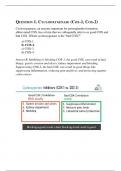QUESTION 1. CYCLOOXYGENASE (COX-1, COX-2) Cyclooxygenase, an enzyme important for prostaglandin formation, abbreviated COX, has a form that we colloquially refer to as good COX and bad COX. Which cyclooxygenase is the “bad COX?” a) COX -1 b) COX -2 c) COX -3 d) COX -4 Answer B. Inhibiting or blocking COX -1, the good COX, can result in bad things: gastric erosion and ulcers, kidney impairment and bleeding. Suppresssing COX -2, the bad COX, can result in good things like suppressing inflammation, reducing pain and fever, and protecting against colon cancer. QUESTION 2. RESULTS OF BLOCKING COX -2 Drugs like ibuprofen, naproxen, and meloxicam affect cyclooxygenase. When we have inhibition of cyclooxygenase -2 (COX -2) we might expect all of the following except: a) Analgesia and antipyresis b) Colorectal cancer protection c) Gastric ulcers d) Suppressed inflammation C, Gastric ulcers. A gastric ulcer would likely result from blocking the good COX, COX -1. However, if we block COX -2, the bad COX, we get analgesia (pain reduction), antipyresis (fever reduction), colorectal cancer protection, and suppressed inflammation. QUESTION 3: IBUPROFEN VS ACETAMINOPHEN Often patients ask the difference between ibuprofen and acetaminophen. Acetaminophen and ibuprofen share all of the following therapeutic effects except: a) Analgesia b) b) Antiinflammatory c) c) Antipyresis d) d) Pain relief B, anti-inflammatory. While acetaminophen and ibuprofen can provide pain relief (analgesia) and fever reduction (antipyresis), only ibuprofen can provide anti -inflammatory effects. So we have two basic branches, the drug that can’t affect inflammation and the one that can. QUESTION 4. THE CELECOXIB ADVANTAGE 4) What was thought of as a breakthrough was a selective cyclooxygenase inhibitor that might reduce GI distress from NSAID use. An arthritic patient with a history of GI distress and bleed might be a candidate for: a) Celecoxib b) Ibuprofen c) Naproxen ) Meloxicam A, celecoxib. Celecoxib was meant to protect against GI distress, but cardiac issues came up as patients took it reducing its utilization. Ibuprofen, naproxen, and meloxicam would likely eventually cause GI distress. QUESTION 5. THE DAILY ASPIRIN ISSUE In pharmacology, the best practice in using a medication can change even with the most common medicines. What concern about daily aspirin led to a change in the way prescribers look at it for protecting against cardiac events? a) Bleed risk that can outweigh protective benefit b) No longer suppresses platelet aggregation c) No longer protects against MI d) No longer protects against stroke A, Bleed risk that can outweigh protective benefit. While aspirin still suppresses platelet aggregation and can work to prevent MI and stroke in patients, the bleed risk is a concern. The new guidelines don’t apply to those who had a stroke/heart attack, underwent bypass surgery or had a stend procedure. These new guidelines apply to otherwise healthy adults and elderly with a high internal bleed risk.




